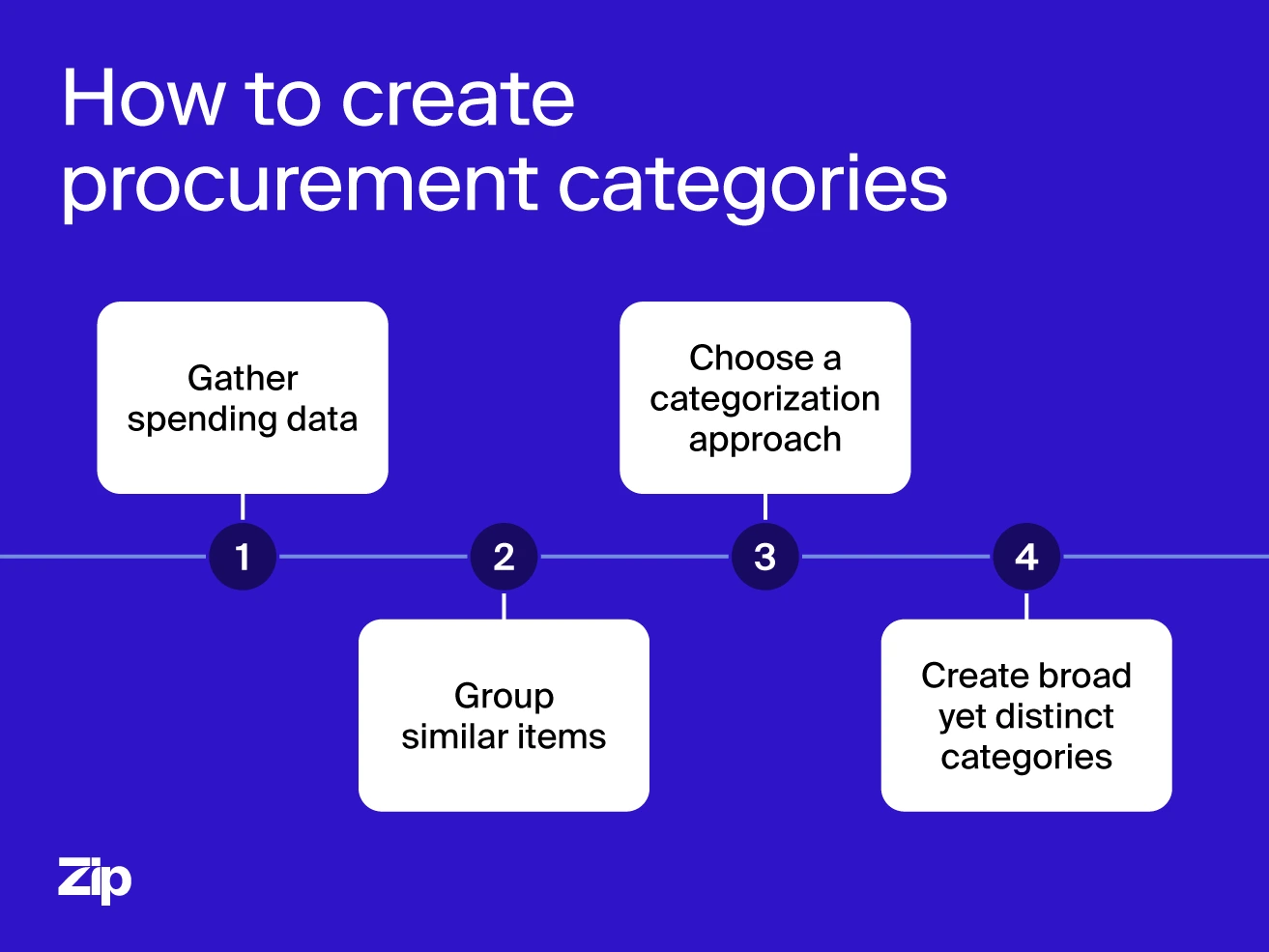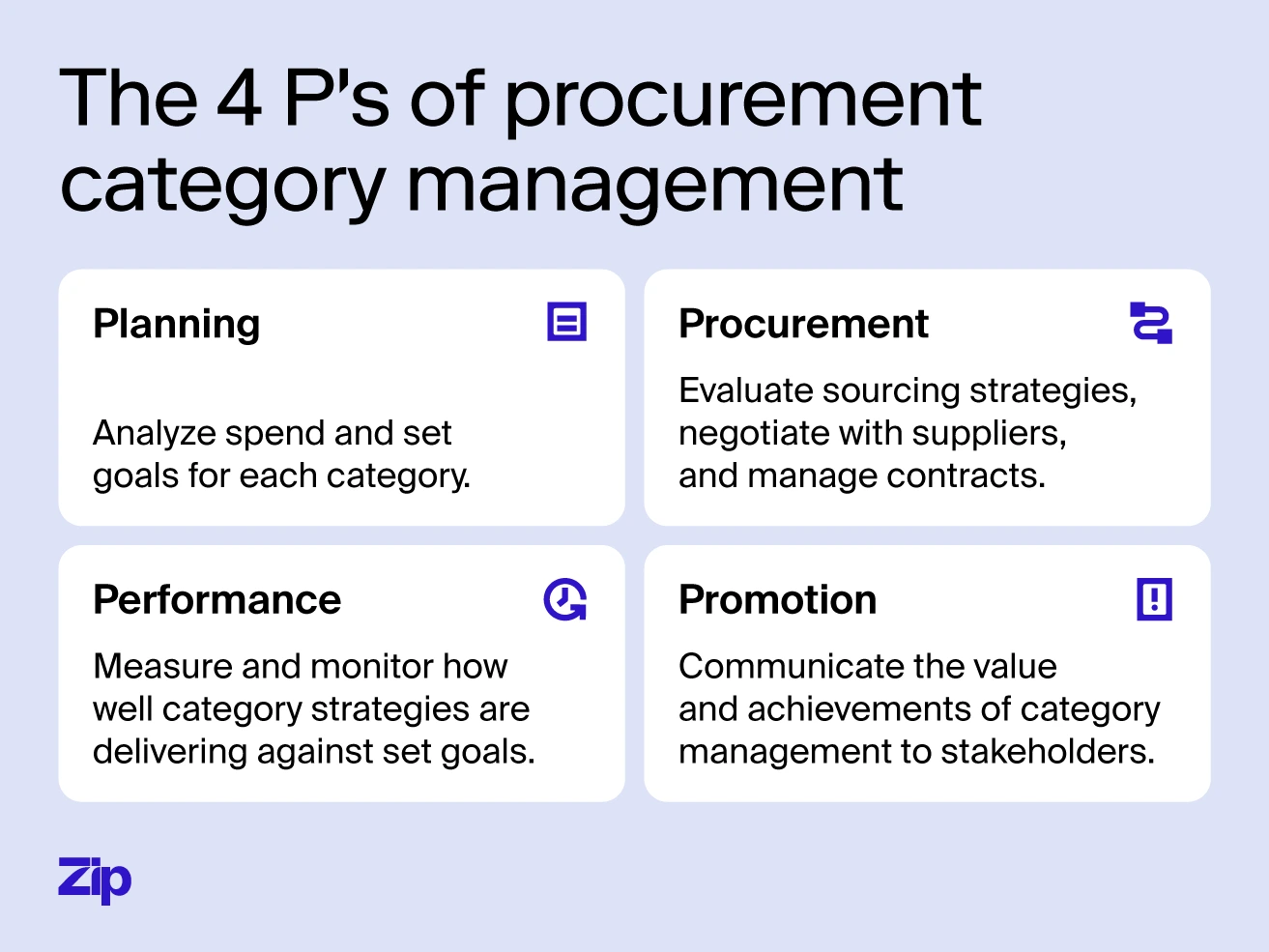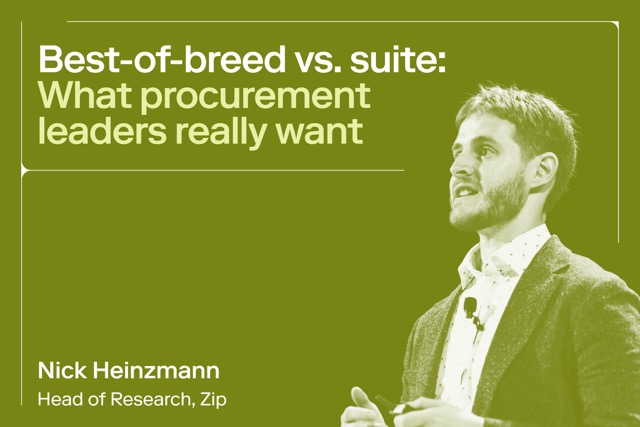
Procurement category management: A complete guide + benefits
Learn how the right category management strategies can supercharge your process.

Ready to stop leaving money on the table in your procurement efforts? Many organizations still view procurement as a purely transactional function, a necessary evil that simply cuts purchase orders and processes invoices. But what if there were a strategic approach that could unlock significant savings, mitigate risks, and even drive innovation within your supply chain?
This article dives deep into procurement category management, a powerful strategy that transforms purchasing from a reactive activity into a proactive, value-generating engine. From understanding its core principles and implementation steps to highlighting the tangible benefits it delivers, we'll equip you with the know-how to revolutionize your procurement practices and elevate your organization's financial performance.
What is procurement category management?
Procurement category management is a strategic framework that shifts procurement from simply processing individual purchases to managing entire groups of similar goods and services, known as categories. Instead of buying pens and paper as separate items, for instance, a category manager would oversee office supplies as a whole, looking at everything from the overall spend to market trends and supplier performance within that specific area.
By segmenting spend into manageable categories, businesses gain deep insights into expenditures, identify cost reduction opportunities, and optimize supplier relationships. This shifts procurement beyond transactional buying to a proactive strategy where specialized expertise for each category leads to smarter sourcing, less risk, and a greater impact on the bottom line.
How procurement category management works

So, how do you actually go about carving out these categories? It starts with digging into your organization's spending data. You'll want to gather every piece of information on what you buy, from whom, and how often.
Once you have this raw data, you'll group similar items together based on their characteristics, how they're used, or even the suppliers that provide them. The goal is to create logical groupings that make sense for strategic management, allowing you to focus your efforts where they'll have the most impact.
There are a few ways to approach the actual creation of your categories. You can start by looking at your current spend and identifying the biggest buckets of expenditure. Alternatively, you might segment based on industry standards, the type of market for the goods, or even internal business unit needs. The key is to be consistent and create categories that are distinct enough to manage strategically but broad enough to leverage your purchasing power.
Here are a few common ways to create categories:
- Spend-based grouping: This involves analyzing your purchase data to identify where the bulk of your money is going and then creating categories around those high-spend areas. For example, a company might establish a "Logistics and Shipping" category if transportation costs are a major expenditure, or "IT Hardware and Software" if technology purchases dominate their spending.
- Market-based categories: This approach involves grouping items based on the external market they belong to, such as raw materials, finished goods, or professional services. An example would be a "Chemical Feedstocks" category for a manufacturing firm, or "Consulting Services" for a business that frequently hires external experts.
- Supplier-centric categories: Sometimes, it makes sense to group categories based on the primary suppliers, especially if you have strategic relationships with certain vendors. For instance, if a company relies heavily on one major cloud provider, they might create a "Cloud Services - [Provider Name]" category, or a "Facility Maintenance - [Key Vendor]" category if a single contractor handles most of their building upkeep.
- Internal business needs: This method involves developing categories around the specific requirements of different departments or business units within your organization. Examples include "Marketing Services" for the marketing department, "Laboratory Equipment" for research and development, or "Human Resources Software" for the HR team.
- Risk and criticality: This involves categorizing items based on their importance to operations or the level of supply chain risk they present. A "Mission-Critical Components" category might be established for parts that would halt production if unavailable, or a "High-Value Raw Materials" category for inputs that are volatile in price or scarce in supply.
Key benefits of procurement category management
Why should your organization care about implementing a category management system? The benefits extend far beyond just cutting costs, impacting everything from operational efficiency to strategic resilience.
Here are some of the key advantages your business can realize:
- Significant cost reduction: By getting smart about how you buy across an entire category, you can consolidate your spend, negotiate better deals, and find more cost-effective suppliers, leading to serious savings.
- Enhanced supplier relationships: Category managers become experts in their specific areas, allowing them to build stronger, more strategic partnerships with key suppliers. This often means better service, faster innovation, and even preferential treatment.
- Mitigated risk: When you understand the unique risks within a category—like potential supply chain snags or wild price swings—you can build proactive strategies to keep things running smoothly, no matter what.
- Improved efficiency and productivity: Standardizing processes and using smart tech like automation within categories cuts down on manual work, speeds up your buying cycles, and frees up your procurement team to focus on more strategic initiatives.
- Greater transparency and control: Category management shines a light on your spending patterns and how well your suppliers are performing. This clearer view leads to smarter decisions and helps ensure everyone's playing by the rules.
- Drives innovation: By working closely with suppliers who specialize in a particular category, you can tap into fresh ideas, cutting-edge technologies, and new solutions that can really boost your products and operations.
.webp)
The pillars of procurement category management

The entire structure of strategic procurement category management is built upon a few key pillars that are absolutely essential for its success. These are the fundamental components that, when executed effectively, transform your procurement efforts from chaotic to strategic (and no, we didn't intentionally make them all start with "P" for some clever alliteration):
- Planning
- Procurement
- Performance
- Promotion
Mastering these areas is essential for unlocking the full potential of category management and ensuring it delivers real, measurable value to your business.
Planning
This is where the strategic heavy lifting happens. The planning pillar dives into your spending data to truly get a handle on what you're buying, from whom, and why. A solid plan means setting clear goals for each category, spotting potential risks and big opportunities, and mapping out how you'll handle everything from strategic sourcing to managing suppliers and creating value within that specific area.
This initial phase lays the groundwork for everything that follows. Without thorough planning, your procurement efforts risk being reactive and fragmented, meaning you'll miss out on major savings and strategic advantages.
Procurement
Once the planning is locked in, the procurement pillar puts those strategies into action. This involves running the sourcing events, hammering out contract details, and picking the best suppliers for each category. It's where the rubber meets the road, turning your carefully crafted category strategy into tangible agreements.
This phase also covers the day-to-day operations of purchasing, making sure everything from ordering goods and services to getting them delivered and paid for runs smoothly and efficiently. It demands sharp negotiation skills, meticulous contract management, and a deep understanding of what your suppliers are truly capable of, all to ensure your chosen vendors consistently meet your organization's needs and help hit those overall category goals.
Performance
The performance pillar is where you measure and monitor your procurement KPIs. Once contracts are signed and suppliers are delivering, it's essential to track how well your category strategies are actually performing against the goals you set during planning. This means keeping a close eye on key metrics like cost savings achieved, supplier performance, compliance rates, and even the level of innovation brought by your suppliers.
Regular check-ins and data analysis are essential for figuring out what's working and what's not. This constant feedback loop allows category managers to quickly tweak their strategies, fix problems as they pop up, and make sure each category keeps delivering maximum value over time. It transforms procurement into a data-driven powerhouse that can clearly show its positive impact on the company's bottom line.
Promotion
The promotion pillar showcases the successes and value of your procurement category management efforts across the entire organization. This goes beyond just giving yourself a pat on the back—it's about making sure everyone understands the benefits being delivered, getting their buy-in, and securing ongoing support for all your procurement initiatives. It involves sharing insights, highlighting big wins, and clearly demonstrating how category management contributes to the company's bigger-picture goals.
Effective promotion helps break down internal barriers and solidifies procurement's role as a true strategic partner, not just a department that handles transactions. By clearly explaining the impact on costs, risks, and innovation, procurement teams can build credibility, influence key decisions, and encourage much stronger collaboration with other departments.
Procurement category management best practices
Ready to make procurement category management a reality in your organization? It takes more than just understanding the concepts—you need to put certain best practices into play to truly see the benefits:
- Create a dedicated category management team: Designate a specific team or individuals whose primary focus is on category management. These experts can dive into procurement analytics, market trends, and supplier performance, developing specialized strategies for each category to maximize value.
- Include third-party data: Don't limit yourself to internal spend data. Integrate external market intelligence, industry benchmarks, and supplier risk assessments from third-party sources. This broader view provides a more complete picture, enabling smarter, data-driven decisions and better negotiation leverage.
- Establish quality supplier relationships: Move beyond transactional interactions and build strong, collaborative partnerships with your key suppliers. By fostering trust and open communication, you can unlock innovation, improve service levels, and achieve more favorable terms over the long term.
- Have a standardized categorization process: Implement a clear, consistent method for defining and organizing your spend categories across the organization. Standardization ensures accuracy, avoids duplication, and makes it easier to analyze data and apply strategies effectively.
- Regularly update stakeholders: Keep all relevant internal stakeholders—from finance to individual business units—informed about category strategies, progress, and achieved benefits. This continuous communication builds buy-in, ensures alignment, and positions procurement as a valuable strategic partner.
- Take advantage of automated solutions: Leverage technology like spend analytics tools, AP automation solutions, and contract management systems. These tools can help streamline processes, provide real-time insights, reduce manual errors, and allow your team to focus on more strategic activities.
- Continue updating the process: Procurement category management isn't a one-and-done deal—it's an ongoing process. Regularly review and refine your categories, strategies, and processes based on market changes, internal needs, and performance results to ensure continuous improvement and sustained value creation.
How to choose the right procurement category management software
To truly get the most out of procurement category management, you'll need the right software to back your efforts. Knowing what capabilities to look for in these solutions is important for transforming your procurement function from good to great.
- Seamless integration: The software should effortlessly connect with your existing enterprise resource planning (ERP) systems, financial tools, and other relevant platforms. This ensures data consistency, eliminates manual data entry, and provides a unified view of your entire procurement landscape.
- Workflow automation: Look for features that automate repetitive tasks, such as purchase order generation, approval routing, and contract renewals. Automation reduces manual errors, speeds up processing times, and allows your team to focus on more strategic, value-adding activities rather than administrative burdens.
- Customizable processes: The software should be flexible enough to adapt to your organization's unique procurement policies, category-specific workflows, and approval hierarchies. Customization ensures the solution aligns with your business's specific needs rather than forcing you into a rigid, one-size-fits-all approach.
- AI-powered insights: Advanced analytics and artificial intelligence capabilities can sift through vast amounts of spend data to identify hidden patterns, potential savings opportunities, and emerging risks. These insights help category managers make more informed, proactive decisions and uncover value that might otherwise go unnoticed.
- Enhanced risk management: The software should offer features that help identify, assess, and mitigate various supply chain risks, such as supplier solvency issues, geopolitical instability, or material shortages. This includes capabilities for supplier vetting, performance monitoring, and real-time alerts to protect your organization from potential disruptions.
Simplify procurement category management with Zip
We've unpacked how procurement category management shifts purchasing from just buying stuff to strategically powering your business, diving into its definition, how to build smart categories, its essential pillars, and key best practices. And when it comes to putting all that into action, the right software makes all the difference.
For organizations ready to seriously level up their procurement game, Zip's procurement orchestration solutions can significantly enhance procurement management strategies. It brings AI-powered insights, seamless integrations, and automated workflows that streamline the entire process and maximize value.
Request a demo and experience the difference this strategic shift can make with Zip.

Maximize the ROI of your business spend

Enter your business email to keep reading


























.webp)




















.avif)













.avif)










.webp)





.avif)












.avif)
